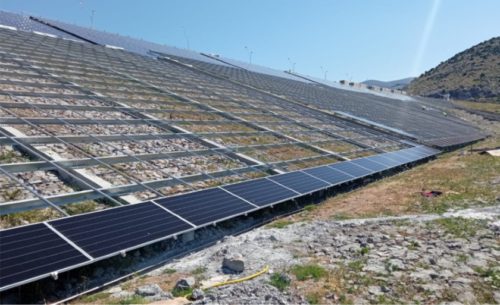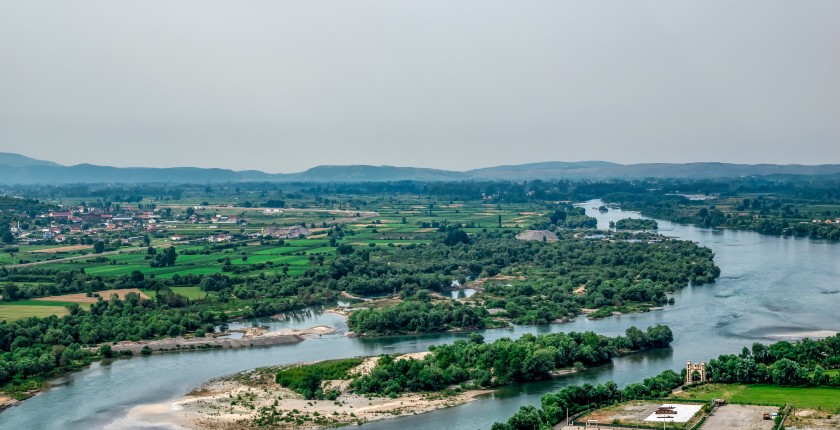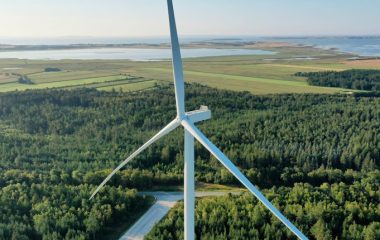
Photo: KESH
Hybrid power plants are emerging as an essential ingredient for a world with net zero emissions. Determined to keep its electricity system clean, Albania wants to go a step further. State-owned utility KESH added a ground-mounted solar power unit to one of its main hydroelectric stations, but the idea is to integrate a floating photovoltaic plant and a wind park as well. It is an opportunity to create a globally unique model for combining renewable energy technologies.
Albania has a specific electricity production system. The Balkan state has predominantly relied on hydropower technology – it accounts to more than 99%, the highest share in Europe and some of the largest in the world.
It means decarbonization isn’t an issue for the sector, but climate change is making droughts more frequent, so the country often needs to turn to emergency power imports. In addition to the fact that expensive electricity from abroad is already hurting public finances, Albania will need massive investments to produce enough for its own needs but also to meet the expected growth in demand for clean heating, cooling and electric mobility.
Albania is pursuing an aggressive strategy of energy diversification and keeping the focus on renewable sources
The government launched “an aggressive strategy of diversification” in 2019, Deputy Prime Minister and Minister of Infrastructure and Energy Belinda Balluku recently pointed out and reiterated that it remains dedicated to deploying renewables.
Karavasta, the biggest solar power plant in the Western Balkans, is now under construction after French company Voltalia won the project at an auction. It has another photovoltaic unit in the pipeline under the same model.
The government is subsidizing the installation of solar thermal systems for households. It is also working to expand the number of prosumers, electricity consumers that also have photovoltaic panels and produce electricity. But it was a project for the combination of four renewable energy technologies that earned a spot among the Energy Transition Champions in the Western Balkans, promoted by Balkan Green Energy News.
Top tier green tech to catapult aging facility to futuristic mode
Vau i Dejës, one of the biggest and oldest hydropower plants in Albania, is turning into an integrated energy production hub. Built in 1970 and run by state-controlled power utility KESH (Korporata Elektroenergjitike Shqiptare), it is the last in the cascade of its three facilities on the Drin river. Privately owned hydropower units Ashta 1 and 2 are right beneath Vau i Dejës.
The 250 MW hydroelectric station, located in the country’s northwest, has recently added a 5.1 MW solar power unit on its Qyrsaq dam. It is the first example in the Western Balkans of combining hydropower and photovoltaics. However, the ambition doesn’t stop there, as a tender procedure is underway to install a floating solar power plant on the reservoir.
A year ago Balluku said the system would be boosted with a wind power plant as well. It would make it the first utility-scale hybrid power plant of its kind in the world at the moment.

Vau i Dejës is riding on global hybrid power wave
Hybrid solutions are emerging as an essential factor in the efforts to cut net greenhouse gas emissions to zero. There are still relatively few such power plants on the planet. Many include diesel generators or other power production facilities that use fossil fuels.
On the other hand, plans for the integration of electricity from multiple renewable sources and batteries are springing up everywhere. For instance, total project pipeline in the United States has exceeded the existing installed capacity in the country.
Turkey, which already had a massive hybrid power plant portfolio, is experiencing another boom with the benefits that the government rolled out for investments in energy storage. Elsewhere in Southeastern Europe, companies are mostly still in the planning stage or doing pilot projects, on a small scale. In Slovenia, a hydropower plant added solar capacity last summer.
Renewable hybrid power gaining edge in energy transition
All in all, it wouldn’t be a surprise if within a few decades most active power plants in the world are hybrids. Many existing facilities can be transformed by adding one or several more sources, just like KESH is doing, laying the foundation for a new energy system.
If KESH integrates both ground-mounted and floating solar and a wind park with the old hydroelectric plant, it could serve as a model for hundreds of more facilities throughout the globe
Like with every new solution in technology, there is a number of unknowns regarding system stability and managing the operation of the plant. If the utility integrates both ground-mounted and floating solar and a wind park with the old hydroelectric plant, it could serve as a model for hundreds of more facilities throughout the globe.
The endeavor also has the potential to brighten Albania’s place on the energy map as a pioneer in new technologies, particularly in Southeastern Europe.
The idea behind modern hybrid power plants is to balance an intermittent source with energy from another system. The most obvious pair are wind and solar energy, as wind is stronger at night and in the winter while photovoltaics only produce during the day and the peak is in the summer. It enables a more predictable total output for the operator.
In another version a geothermal power plant can be matched with solar or wind or both, and so on. Surplus power can be stored in batteries for usage when production unexpectedly weakens.

Another dam at Vau i Dejës to be equipped with solar panels
Hydropower depends on the weather, too, so it is a good candidate for an upgrade. On the bright side, their ability to control the water level in the reservoir helps to adapt to changes in demand.
Major hydroelectric systems are especially suitable. They are already connected to the transmission network and usually have accessible dams for ground-mounted solar as well as reservoirs for floating photovoltaics, popularly called floatovoltaics.
The solar power unit on the Qyrsaq dam occupies more than two and a half hectares of 3.2 hectares in total. KESH already plans to build another one, on the Zadeja dam at Vau i Dejës. The future 8.25 MW system is envisaged to span 40 hectares, compared to 48.6 hectares of total area.
Floating solar project in Albania would currently be biggest in Europe
The floating solar park should have 12.9 MW in peak capacity. It would currently be the largest in Europe. KESH intends to lay the panels on 11 hectares or 0.45% of the lake’s overall surface. It expects average annual output of 17.6 GWh. The project is valued at EUR 13.9 million, of which 70% will be covered with a loan from the European Bank for Reconstruction and Development.
Of note, Norwegian green energy company Statkraft has installed a floating solar power plant in Albania in 2021 on the reservoir of its Banja hydropower plant, which is another first for the country. The advantage of floatovoltaics is that they can be installed without property ownership issues. Moreover, water cools the panels, and in turn they reduce evaporation.
Water cools the panels from underneath and in turn their shadow reduces evaporation from the lake
KESH is showing determination to assume a significant position in the new sector. Almost two years ago it founded a subsidiary called Solar Energy of Albania – SENA. It is responsible for the floating solar power project, but also for future photovoltaic endeavors including maintenance.
Explosive growth in hybrid capacities on a global scale is offering the utility a possibility to make a name for itself with an original solution by developing a smart operating system at Vau i Dejës.









This project is amazing and will improve the energy supply for the country and not limited to. I would like to be part of this project as an environmental Engineer .